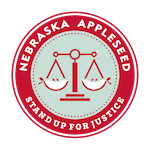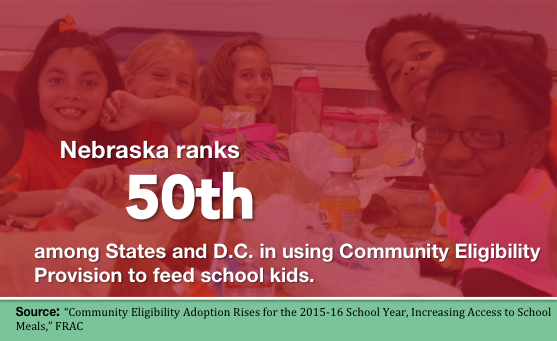***For Immediate Release***
April 7, 2016
Contact, Jeff Sheldon
Communications Director, Nebraska Appleseed
Office: (402) 438-8853
Mobile: (402) 840-7289
jsheldon@neappleseed.org
New report shows Nebraska lagging nationally in helping kids get meals at school
Nebraska ranked nearly last in using Community Eligibility Provision
Despite a significant nationwide increase in the number of high-poverty schools helping feed students with new federal funding, Nebraska ranked near the bottom nationally in providing access to school meals for all students using the new Community Eligibility Provision (CEP).
A report released Thursday by the Food Research and Action Center (FRAC) found that Nebraska holds the second-lowest rate among 50 states and the District of Columbia in eligible schools using CEP to help students get the healthy meals necessary for classroom focus, learning, and overall health.
Read the full report, “Community Eligibility Adoption Rises for the 2015-16 School Year, Increasing Access to School Meals”
According to the report, in the 2015-16 school year only nine out of Nebraska’s 112 eligible schools chose to participate in CEP, a program started in 2014 that allows schools to receive federal reimbursement to provide breakfast and lunch to all students free of charge to the students’ families. This ensures all students have access to meals, reduces administrative burden, saves schools money, and eliminates the stigma some students feel for receiving free or reduced-price meals.
Nebraska’s 8 percent participation rate among eligible schools ranked only ahead of New Hampshire.
“We know child hunger is a barrier to success in the classroom in our state. This ranking shows how much more we need to do to help our students get the meals that experts say are essential to learn and grow,” said Nebraska Appleseed Economic Justice Director James Goddard. “Community Eligibility has proven to be a valuable tool across the country to give food security to kids from low-income families, and using it in Nebraska would be a very effective way to ensure students are entering our classrooms with a full stomach and ready to learn.”
Nebraska’s sluggishness to adopt CEP in eligible schools bucks a national trend according to the report. The 2015-16 school year saw a nationwide increase of nearly 4,000 participating schools, which further shows the appeal of the provision. More than 18,000 eligible schools in 3,000 school districts across the U.S. are participating in CEP in 2015-16, which is the second year the program has been in existence nationwide.
North Dakota, which had a 100 percent participation rate among eligible schools, led the nation in CEP participation, according to FRAC’s report. Meanwhile, West Virginia, Kentucky, Hawaii, the District of Columbia, Delaware, Montana, New Mexico, and Alaska each had a participation rate of at least 70 percent.
“The increase in schools across the U.S. that have taken up CEP shows how effective a tool it can be to fight hunger in our classrooms,” Goddard said. “We encourage all eligible Nebraska schools to considering utilizing CEP to make sure every student is getting the meals they need to succeed in school.”
Nebraska’s ranking in Thursday’s report continued our state’s troubling trend in ensuring students have access to meals at school, particularly school breakfast. In February, another report from FRAC showed Nebraska ranked 49th out of 50 states and D.C. in providing eligible children with school breakfast.
According to FRAC’s School Breakfast Scorecard, only 40.8 percent of Nebraska students who participated in the free and reduced-price lunch program also participated in the school breakfast program in the 2014-15 school year.


